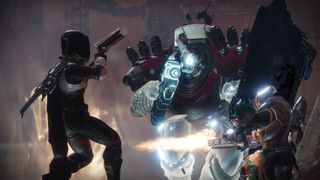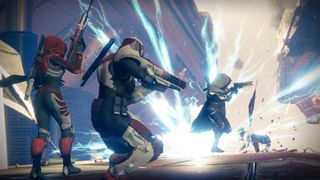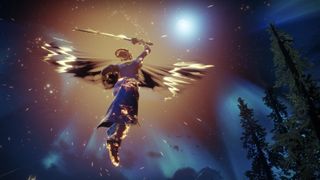
After our first big hands-on with Destiny 2 at the reveal event, we spoke with director Luke Smith for a forthcoming cover feature, highlights of which you can read here. At E3 last week we were finally able to capture footage from the PC version—4K, 60 FPS video and played on a mouse and keyboard—and also once again sat down with Bungie’s PC lead David Shaw to dig deeper into Destiny 2’s PC build. This time he was joined by senior software engineer Thomas Gawrys of Vicarious Visions, the studio that is Bungie's development partner on PC.
Unsurprisingly there were some topics the two weren’t able to discuss yet, but there's plenty of new detail below on what to expect from the PC build of Destiny 2, which at this point (annoying platform exclusives aside) is clearly going to be the definitive version of Bungie's shared-world sci-fi shooter sequel. Or SWSFSSS, as no-one's calling it.
This interview has been edited and arranged for length and clarity.

PC Gamer: Last time we spoke we talked about release dates. Now we know that the PC version of Destiny 2 will arrive in October, about a month and a half after the consoles. What are you going to focus on during that extra time to make sure it’s spot-on?
David Shaw: It’s a really simple answer. You actually said it: we’re using that time to make sure we get it right. When you think back, we heard the clamour for PC all the way back before [Destiny 1] launched. We heard the message, we understood it, we knew that PC gamers really wanted to play Destiny, and we just didn’t think we could do it right. And we weren’t going to do it until we could.
Was that because Bungie was supporting two sets of consoles?
DS: We had a lot of platforms. We had four platforms we were supporting, so that was part of it. But when we got to the point where we were thinking about Destiny 2, we felt we had the team, the talent, we reached out and found a great partnership with Vicarious Visions. That six weeks is basically one of those pieces that we need to make sure that when we deliver [Destiny 2]—I’ll go back to the same phrase—that we’re legit on day one. That’s the goal.
PC Gamer Newsletter
Sign up to get the best content of the week, and great gaming deals, as picked by the editors.
Did you create a new engine and toolset for Destiny 2 to help alleviate bottlenecks? There were horror stories about it taking eight hours to move an object in a map.
DS: Without getting into much detail, we’ve actually kind of restructured our studio a little bit over the years. We have a team that we call the engine lane, and that team is very much focused on future, forward stuff—things that are either way out or a little bit out. And a lot of what they’re working on is workflow. So we’ve now got this very codified investment in making our experience better as content creators and as engineers and as anybody who is inputting into the game. We want to make that as smooth as possible.
Thomas Gawrys: There’s definitely been improvements this time around, but we can’t really talk about the intricate details of how much things have improved.
Have you made any technological or logistical improvements that will enable your team to iterate on content more quickly?
DS: Yeah, all the improvements absolutely will, and we’re going to continue to make more improvements. But one of the things that we’ve found is that the Destiny player consumes content at a rate that we just can’t [keep up with].
TG: It’s ridiculous, honestly.
DS: As fast as we can possibly make it in the most optimal situation still wouldn’t be fast enough. So we’re not only trying to improve our workflows—not only for the player benefit but for our own benefit as well—we’re also looking into ways of making the content that we’ve got more interesting, and continuing to evolve our end-game. Working with partners like VV, they are an extension of the team in many ways.
People hear about working with partners and they think “oh, they’re outsourcing that, they’re not really taking it seriously.” That’s not how we’ve approached it. It’s a true partnership. Half of the PC leadership team is at Bungie and the other half is at VV. We work all the time together. We’re approaching it from as many avenues as possible. Everybody will always want more than we can make, but how do we get to that point where we’re just coming in and constantly shipping amazing stuff?
TG: We have the season pass, so we are planning other things. We’re not here to talk about those today, but we’re planning to have additional content for folks.

That makes it sound like Destiny 2’s post-release content plan is similar to Destiny 1’s, just a bit more efficient. Is that fair?
DS: Yeah, and we’ve been working on that since, frankly, even before launch. This is just what you do to make your life easier as a developer. You always want to be able to make more and better content. So that is just a fundamental thing we will always do.
We can’t make enough that you guys won’t chew through it really quickly. Again, that’s why we we’ve added things like Adventures and Lost Sectors. These are things that are not as full-bodied as a Strike in the cost it takes to develop them, but they’re still really rewarding and they give us opportunities to give you more. The Adventures are about “hey, I really want to learn more about this destination,” and take you along that path. Whereas the Lost Sectors are, “hey, there’s this bad fucking dude loose in this cave, go kick his ass, take his loot”.
Do you anticipate those being quite replayable?
DS: Absolutely.
TG: I think the thing there, the high-level key, is that the design is built in a way to make it so we’re actively pursuing it at the angle of “hey, can we make stuff faster?” but we’re also pursuing it from the angle of “how can we build a game that provides this avenue for players to re-engage more frequently without feeling like they’re just bored of the content?”
DS: Right. And clearly we got pretty close with Destiny 1. People put a couple hours into it. We got close, we think, and we’re starting with that as a base and thinking about evolving more content, [making] it faster. And we’re shipping the biggest destination we’ve ever shipped with [the European Dead Zone]. We’re shipping all new destinations. I think people maybe expected when we started talking about Destiny 2 that we were going to start talking about “oh, Cosmodrome will have some stuff.” There is no Cosmodrome; the Cosmodrome isn’t a thing in Destiny 2. There really is a lot of content, and we’ve really paid attention to that, making sure it’s all new, it’s all exciting.
When we talked to Destiny 2 director Luke Smith recently, he mentioned being able to balance by platform, so things like bullet accuracy can be tweaked on the PC specifically.
Where it makes sense, we’re trying to make sure we have the capability to tune differently.
David Shaw
DS: So we have this pillar that we call one-design build, which basically means that the way the game is designed, the way it plays, the content, all of that is intended to be as similar as possible across all platforms. That said, where it makes sense, we’re trying to make sure we have the capability to tune differently. A good example of that from the sandbox side is when we talked about our recoil model. On the console—actually just on a controller—the recoil is, you know, you fight it, your barrel is rising. On a mouse that means you’re chasing it and it’s horrible. So we went and we tuned that. Really, the question was “what are the things that add to the PC experience and what are the things that sucked for PC?” And we went and tackled all the ones that sucked.
I noticed in the demo that some weapons felt more stable. It almost felt like auto rifles had gotten a buff.
TG: There’s a different experience with it. A lot of what the folks at VV do is look at those differences and try to match the feel, but it has to feel good playing with mouse and keyboard. We don’t want to make it so it’s not a good experience with the most common input, you know? So we had to change it slightly, and it does mean that we need to enable ourselves to tune it if things arise.
DS: And we’re still working on it. The build you’ve played twice now is an older build, and we’re continuing to tune the sandbox play. And not only did we tune the gameplay just to basically say “this is a console game, we need a legitimate, awesome first-person shooter feel that still feels like Destiny.” So we did all of that, we changed the things we needed to change to make it feel good. And by the way, you guys wrote some really complimentary stuff. But we’ve also made sure that, even within the simpler things, we want to keep that consistent feel. And we’ve made decisions where we’ve said “hey, this plays really well on console but it’s not going to play really well on PC, so let’s figure out how to make something that works well in multiple places and works across all the platforms.” But we do have that ability if we find that, you know, sniper rifles have this weird thing that we want to tune just a little bit, we can do those things. But we’re going to do everything we can to keep consistency.
Is it easier to patch the PC version because you don’t have to go through QA with Sony and Microsoft?
DS: It depends. Our intent is to be able to patch as needed. Exactly how we’re going to do that we’re not yet talking about. And yes, the things we might want to patch, like if there’s a sniper rifle, we can actually patch that without touching the console [versions].

So far no one has seen any machine guns in the power slot from the demo builds. Are machine guns gone?
DS: You’re talking about the [heavy weapons]? I don’t know if we’re talking about HMGs. You’ll have to wait and see.
In the homecoming mission we’ve been playing at E3, the bits with Zavala and Ikora are heavily scripted beats to introduce you to those characters and what’s cool about them. Are there going to be moments in Destiny 2 where you’re fighting alongside NPCs that are doing their own thing? Or will it always be scripted?
DS: The key thing about the story and the campaign is that you’re the hero. We want to honor that, we want that to be key and central all the time. So, I think with a story like that you have to tell it a certain way to some degree. But we’ve absolutely recognized that, through the evolution of [Destiny 1], we had characters that kind of came into their own and became these key, amazing things. Cayde, Ikora, Zavala, Amanda Holliday, we’ve got these great characters that are absolutely helping us tell the story.
What no love for Eris?
DS: I love Eris too! We haven’t shown Eris in anything. I don’t even know if Eris is in the game. But there’s lots of characters, and we’ve recognized that they’re powerful. But we’re still telling your story, so we’re trying to make sure that we focus and really leverage those characters to help us tell your story. We’ve got more cinematics than we’ve ever shipped. I think you’re going to find that it’s a totally different feel.
So I shouldn’t expect to run around alongside Cayde while he’s shooting stuff and doing his own thing.
DS: You’ll have to wait and see.
I don’t think you should expect that if we’re going to remaster something, we’re going to remaster them all in the same direction.
David Shaw
Given the changes to the Striker subclass and the Fist of Havoc super, should we expect to see the Warlock’s Nova Bomb also reworked into a roaming super?
DS: With the supers that we’re bringing into Destiny 2 from Destiny 1, we refer to them as being remastered. But I don’t think you should expect that if we’re going to remaster something, we’re going to remaster them all in the same direction. Whatever expectations you have, they may or may not be met, whether it comes back or not.
TG: I think another way to think about it is, when we’re looking at these subclasses and these abilities, we’re trying to make these things more skillful, to give people a chance to learn and grow in what they’re playing. If you want to think about direction, that’s a super high-level direction with these things.
DS: When I first played the Titan with the Fists of Havoc and multiple shots, I was like “hell yeah, that’s awesome.” But they’re also not “wherever you hit, you’re going to blow some shit up.” It is more controlled and more careful, and you have to think a little bit more, and aim a little bit better. I think we’ve amped up that—it’s less fire and forget or just button mash, and more about skillful engagement.

Like with Dawnblade where you’re choosing to do the ground slam or swing the sword.
TG: Exactly, it’s a tactical choice. The player’s choice.
DS: Same with Arcstrider, right? I didn’t feel like I could miss very much with the Bladedancer. It really felt like I was super-powered and could just go stab everything in the room. And with the Arcstrider, it’s much more of that kung fu master feel with the acrobatics. And I can totally miss. And I do, trust me.
How many subclasses are you planning to ship with?
DS: I don’t think we’re saying that yet.
TG: My answer is no, I can’t say that.
DS: Yeah. Would I like to? Yes. Can I? [Checks with PR person] No.
How do you feel about everyone, and I mean everyone, calling the Arcstrider the pole dancer?
DS: [Laughs] I was ashamed of myself for never recognizing that.
Did no one at Bungie think of that?
DS: I never thought of it, and I am known for bad stuff like that. I was disappointed in myself.
So, the new hub is the Farm. Are there still vendors there selling weapons?
DS: We’re not talking in-depth about what’s available—
TG: [Laughs]
You can’t tell me about the farm?
TG: There’s a farm.
DS: [Laughs] There might be some NPCs there. It seems like a place people might go.
Last one: should we expect substantial changes to the way loot works, or is it going to work roughly the same way Destiny 1 did?
DS: I will say that you will find that there are things that feel familiar, while there are things that are new and surprising and interesting.
The Cryptarch will feel familiar. That’s what you’re telling me.
DS: If there were a Cryptarch. I don’t know that there is.
TG: I think one thing that’s interesting that you can think about with loot is things we have mentioned with Lost Sectors and stuff like that. So there will be new, engaging ways that you play that will get you loot.
With over two decades covering videogames, Tim has been there from the beginning. In his case, that meant playing Elite in 'co-op' on a BBC Micro (one player uses the movement keys, the other shoots) until his parents finally caved and bought an Amstrad CPC 6128. These days, when not steering the good ship PC Gamer, Tim spends his time complaining that all Priest mains in Hearthstone are degenerates and raiding in Destiny 2. He's almost certainly doing one of these right now.
Most Popular






